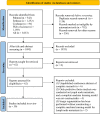The value of machine learning in preoperative identification of lymph node metastasis status in endometrial cancer: a systematic review and meta-analysis
- PMID: 38173835
- PMCID: PMC10761539
- DOI: 10.3389/fonc.2023.1289050
The value of machine learning in preoperative identification of lymph node metastasis status in endometrial cancer: a systematic review and meta-analysis
Abstract
Background: The early identification of lymph node metastasis status in endometrial cancer (EC) is a serious challenge in clinical practice. Some investigators have introduced machine learning into the early identification of lymph node metastasis in EC patients. However, the predictive value of machine learning is controversial due to the diversity of models and modeling variables. To this end, we carried out this systematic review and meta-analysis to systematically discuss the value of machine learning for the early identification of lymph node metastasis in EC patients.
Methods: A systematic search was conducted in Pubmed, Cochrane, Embase, and Web of Science until March 12, 2023. PROBAST was used to assess the risk of bias in the included studies. In the process of meta-analysis, subgroup analysis was performed according to modeling variables (clinical features, radiomic features, and radiomic features combined with clinical features) and different types of models in various variables.
Results: This systematic review included 50 primary studies with a total of 103,752 EC patients, 12,579 of whom had positive lymph node metastasis. Meta-analysis showed that among the machine learning models constructed by the three categories of modeling variables, the best model was constructed by combining radiomic features with clinical features, with a pooled c-index of 0.907 (95%CI: 0.886-0.928) in the training set and 0.823 (95%CI: 0.757-0.890) in the validation set, and good sensitivity and specificity. The c-index of the machine learning model constructed based on clinical features alone was not inferior to that based on radiomic features only. In addition, logistic regression was found to be the main modeling method and has ideal predictive performance with different categories of modeling variables.
Conclusion: Although the model based on radiomic features combined with clinical features has the best predictive efficiency, there is no recognized specification for the application of radiomics at present. In addition, the logistic regression constructed by clinical features shows good sensitivity and specificity. In this context, large-sample studies covering different races are warranted to develop predictive nomograms based on clinical features, which can be widely applied in clinical practice.
Systematic review registration: https://www.crd.york.ac.uk/PROSPERO, identifier CRD42023420774.
Keywords: endometrial cancer; lymph node metastasis; machine learning; radiomics; systematic review.
Copyright © 2023 Ren, Chen, Hong, Yuan, Deng, Chen, Ye and Li.
Conflict of interest statement
The authors declare that the research was conducted in the absence of any commercial or financial relationships that could be construed as a potential conflict of interest.
Figures
Similar articles
-
The predictive value of radiomics-based machine learning for peritoneal metastasis in gastric cancer patients: a systematic review and meta-analysis.Front Oncol. 2023 Jul 3;13:1196053. doi: 10.3389/fonc.2023.1196053. eCollection 2023. Front Oncol. 2023. PMID: 37465109 Free PMC article.
-
Machine learning for lymph node metastasis prediction of in patients with gastric cancer: A systematic review and meta-analysis.Front Oncol. 2022 Aug 18;12:946038. doi: 10.3389/fonc.2022.946038. eCollection 2022. Front Oncol. 2022. PMID: 36059703 Free PMC article.
-
Accuracy of radiomics in the diagnosis and preoperative high-risk assessment of endometrial cancer: a systematic review and meta-analysis.Front Oncol. 2024 Jan 25;14:1334546. doi: 10.3389/fonc.2024.1334546. eCollection 2024. Front Oncol. 2024. PMID: 38344208 Free PMC article.
-
Magnetic resonance imaging radiomics predicts preoperative axillary lymph node metastasis to support surgical decisions and is associated with tumor microenvironment in invasive breast cancer: A machine learning, multicenter study.EBioMedicine. 2021 Jul;69:103460. doi: 10.1016/j.ebiom.2021.103460. Epub 2021 Jul 4. EBioMedicine. 2021. PMID: 34233259 Free PMC article. Clinical Trial.
-
Predictive value of radiomic features extracted from primary lung adenocarcinoma in forecasting thoracic lymph node metastasis: a systematic review and meta-analysis.BMC Pulm Med. 2024 May 18;24(1):246. doi: 10.1186/s12890-024-03020-x. BMC Pulm Med. 2024. PMID: 38762472 Free PMC article.
Cited by
-
XGBoost-based nomogram for predicting lymph node metastasis in endometrial carcinoma.Am J Cancer Res. 2024 Dec 15;14(12):5769-5783. doi: 10.62347/JVRG8195. eCollection 2024. Am J Cancer Res. 2024. PMID: 39803649 Free PMC article.
-
Machine Learning Based Assessment of Inguinal Lymph Node Metastasis in Patients with Squamous Cell Carcinoma of the Vulva.J Clin Med. 2025 May 17;14(10):3510. doi: 10.3390/jcm14103510. J Clin Med. 2025. PMID: 40429505 Free PMC article.
-
Predictive modeling for metastasis in oncology: current methods and future directions.Ann Med Surg (Lond). 2025 May 21;87(6):3489-3508. doi: 10.1097/MS9.0000000000003279. eCollection 2025 Jun. Ann Med Surg (Lond). 2025. PMID: 40486555 Free PMC article. Review.
References
Publication types
LinkOut - more resources
Full Text Sources



